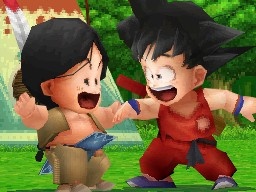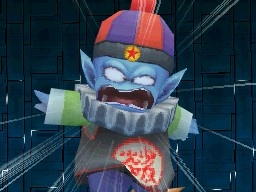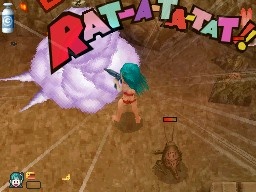At first glance, Dragon Ball: Origins 2 appears poised to follow in the footsteps of its predecessor, an enjoyable adventure with gameplay strong enough to appeal to diehard followers of the anime and the uninitiated alike. But that impression quickly fades, courtesy of this sequel's wildly uneven difficulty and determination to punish you for failure. Origins 2 does have its charms, but they exist in the shadow of its baffling frustrations.

Origins 2 picks up where its predecessor left off, finding young Goku soaring around on the Flying Nimbus, searching for dragon balls with the help of his trusty dragon radar. Along the way, he's hindered at every turn by the evil Red Ribbon Army and aided by a number of friends. It certainly helps to be a series aficionado to jump into this ongoing adventure, but the terrific storytelling here makes the tale accessible and entertaining to fans and newcomers alike. Cutscenes are fully animated using in-game graphics, and while you only get the occasional snippet of voice acting, the personalities of the characters come through loud and clear. It's hard not to be charmed by the sight of the adorable young Goku, supremely confident and bravely stepping forward to fight deadly opponents with a huge, goofy smile on his face.
Unfortunately all that fighting, while pleasant at times, isn't on a par with the excellent storytelling. The main story is broken up into episodes, each one finding Goku or his friends running through an environment and clobbering wolves, Red Ribbon Army soldiers, skeletal pirates, or other enemies who get in their way. Sometimes they'll also solve some basic environmental puzzles of the block-pushing or switch-tripping variety. Goku can attack with his fists or his power pole, having a variety of attacks for each fighting style. He also can unleash a long-range ki blast or the occasional devastating kamehameha. That variety in his repertoire helps make you feel like a skilled and powerful little fighter. It doesn't translate into really rewarding combat, however, because you can typically just pummel your foes with basic attacks and then run into the next area where you get to repeat the process. It's breezy and mildly engaging for a little while, but most levels drag on for far longer than this basic action can sustain them, and reaching the end of a chapter carries with it a sense of relief from what was quickly growing tedious.

The moments of any real challenge are typically found in some of the game's many boss fights, but the way the game often handles this challenge is disastrous because it saps much of the goodwill the lighthearted story and charming visuals may have earned. Losing a boss fight often sends you back to the start of the level that preceded it, forcing you to once again spend many minutes running through rooms, defeating enemies, and going through the motions of solving whatever environmental puzzles are in your way. It turns gameplay that already teeters on the brink of tedium into a kind of punishment for failure. There are some boss fights that do offer save points immediately beforehand, but there are also many that don't, and it's a design decision that's as baffling as it is infuriating. Similarly, there are spots where one boss fight immediately follows another, and if the first fight left you without the health and recovery items you need to win the second, you'll have no choice but to quit out to the menu to take the entire level from the top. Making matters worse, most of the bosses just aren't much fun to fight, requiring a slow and simple strategy of chipping away at their health and then evading their powerful attacks that will quickly put an end to you if they land.
At least there's a bit of variety in the opportunity to play as characters other than Goku from time to time. The hulking android known as Eighter is a pleasant change of pace just because he feels so physically imposing after playing as the quick and tiny Goku. And Bulma uses a variety of guns rather than martial arts, encouraging you to try to keep your distance from enemies. She also has a remote-controlled bomb that can be used to access narrow crawl spaces or cross spiky pits to reach trigger switches on the far side, resulting in a few of the game's more enjoyable puzzle-solving moments. And all of the characters can be controlled with the stylus or the D pad and buttons, so whether you prefer to tap your way around or do things the old-fashioned way, Origins 2 has you covered.

The vivid visuals make the game pleasant to behold. Goku animates smoothly as he charges enthusiastically through the game's environments, his tail swinging back and forth. And seeing "BOMB!" and "BAGOOM!" appear over defeated enemies as they disappear in a puff of smoke gives the action an extra dash of manga flavor. While the environments aren't the most detailed to ever grace the DS, they're quite varied and have some nice touches that lend them life, such as the floating embers that create a sense of urgency in a burning forest. The top screen shows what's above or beyond the area you're currently occupying, sometimes giving you a glimpse of a switch you need to trigger or a treasure chest you can collect and always helping to make the environments feel more expansive. The music is fast paced and suits the action, and the sounds of battle have a satisfying sense of impact to them. Voice clips are used sparingly, but the few that are here help give you a better sense of the characters.
In addition to the standard story mode, there's a boss rush mode called Survival Tower that you can play alone or with a friend, but the boss fights--already often frustrating in the main game--aren't worth revisiting outside the context of the story. Ultimately, the simple action and, particularly, the punishingly poor use of save points make this more a test of patience than an enjoyable escapade. Dragon Ball devotees with strong wills may be willing to put up with the frustrations to eke some fun from the game, thanks to its energetic storytelling, but most adventure seekers should look elsewhere for their next epic quest.